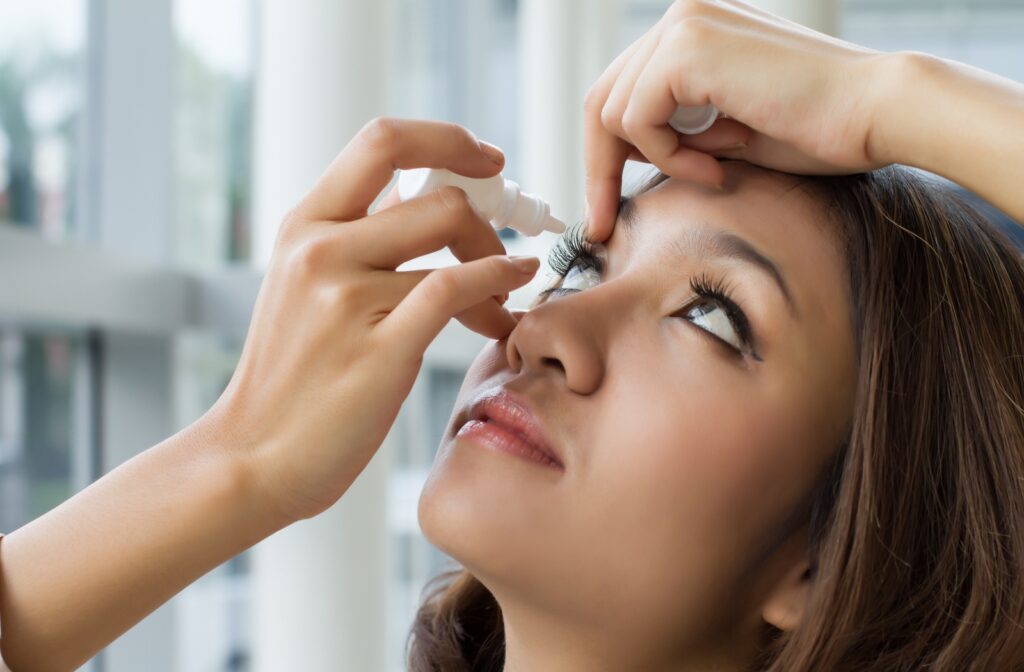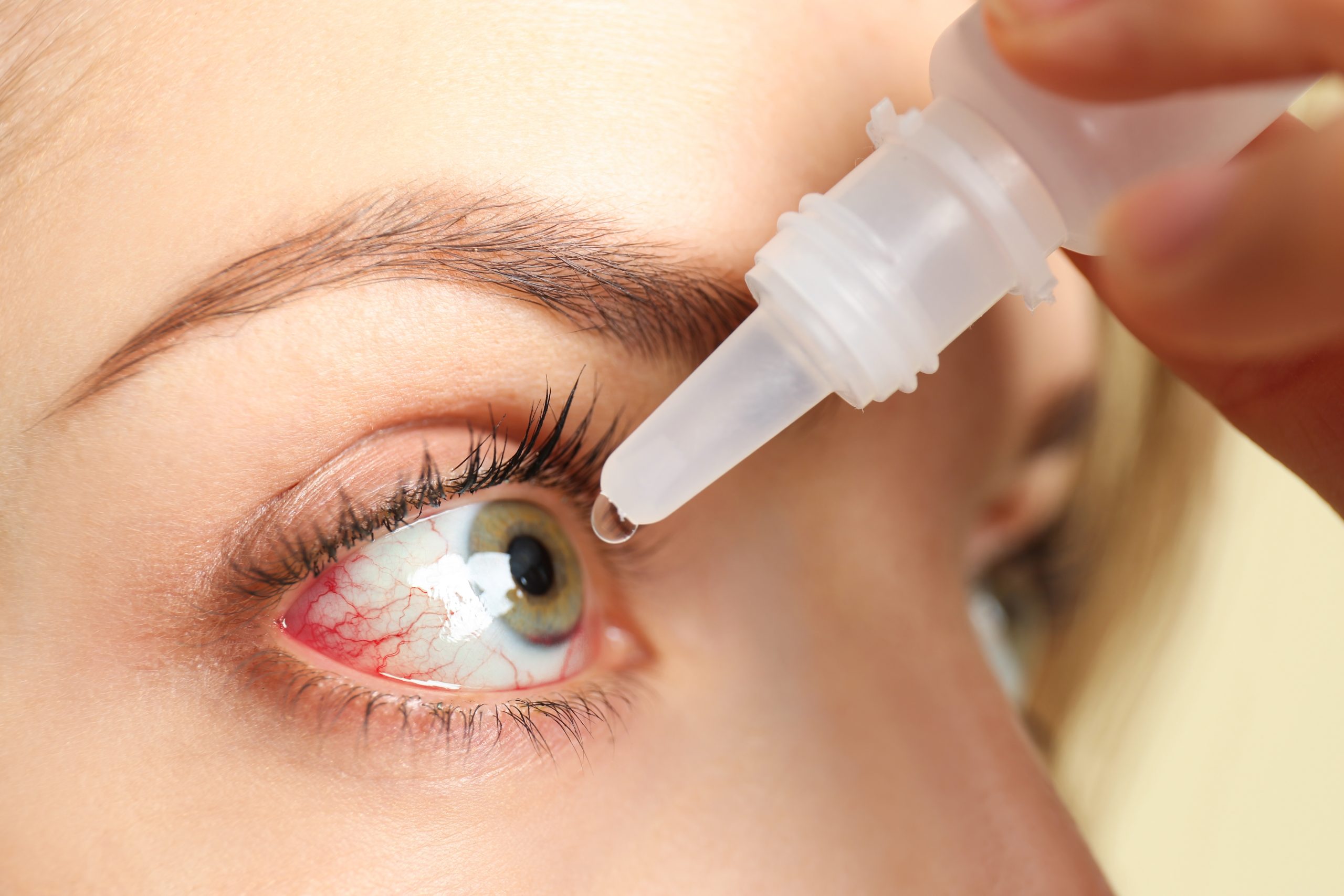Dry eyes, medically known as keratoconjunctivitis sicca, aren’t just a fleeting discomfort; it’s a persistent issue that occurs when tears fail to provide adequate lubrication for the eyes. Contrary to popular belief, dry eyes don’t always equate to an absence of tears. Instead, it’s a complex imbalance where either the quantity or quality of tears falls short, leading to an array of discomforting symptoms.
Tears aren’t just a salty solution that streams down when we’re emotional; they’re a sophisticated blend of water, oils, mucus, and antibodies. These elements work synergistically to keep the eyes hydrated, nourished, and shielded from infections. When this delicate balance is disrupted, it can trigger a cascade of uncomfortable sensations and, in severe cases, impact vision.
The prevalence of dry eyes isn’t limited to a specific demographic—it affects individuals of all ages, genders, and lifestyles. Factors such as prolonged screen time, environmental conditions, certain medications, and underlying health issues contribute to its onset and persistence.
What makes dry eyes particularly insidious is its stealthy nature. Its symptoms can be mild at first, often brushed off as temporary irritation. Yet, when left unaddressed, they can progress into persistent discomfort, blurred vision, and potential complications that, while rarely leading directly to blindness, can significantly impact daily life and eye health.
Recommended: Viagra Blindness In Men: Is It True Or False?
This comprehensive guide aims to unravel the intricacies of dry eyes, dissecting its causes, symptoms, and potential consequences on vision health. By understanding the link between dry eyes and vision, we’ll explore the preventive measures, treatment options, and proactive steps to maintain optimal eye health.
Relationship Between Dry Eyes and Blindness
The link between dry eyes and blindness often raises concerns and misconceptions about the direct causation of blindness by dry eye syndrome. It’s crucial to understand that while chronic dry eyes can significantly impact eye health and visual comfort, they rarely lead directly to blindness.
Dry eyes exist on a spectrum, ranging from mild occasional discomfort to severe, chronic cases that might lead to complications. While severe cases can pose risks to eye health and vision, including potential impairment, the progression to complete blindness solely due to dry eyes is exceptionally rare.
While dry eyes might not directly cause blindness, severe and prolonged instances can indirectly contribute to vision loss through various mechanisms:
- Complications Leading to Visual Impairment: Untreated dry eyes can pave the way for complications like corneal damage, infections, and chronic inflammation. These complications, if left unchecked, can impair visual function and, in extreme cases, lead to partial or severe vision loss.
- Impact on Quality of Life and Functional Vision: Even if dry eyes don’t result in complete blindness, they can significantly impact one’s quality of life and functional vision. Persistent discomfort, visual disturbances, and difficulty performing daily tasks due to eye strain and blurred vision can severely affect overall well-being.
The critical aspect lies in recognizing the potential risks associated with severe and chronic dry eyes. Early intervention and proactive management are crucial to prevent complications that could jeopardize eye health and visual acuity.
Regular eye examinations and consulting an eye care professional are paramount, especially if experiencing persistent dry eye symptoms. This proactive approach allows for timely diagnosis, appropriate treatment, and the implementation of preventive measures to maintain optimal eye health.
Recommended: 11 Common Eye Diseases And How Best To Treat Them
Understanding that dry eyes, while discomforting and potentially affecting vision, seldom directly lead to blindness empowers people to take charge of their eye health. By addressing dry eye symptoms promptly, adopting preventive measures, and following professional guidance, people can mitigate risks and preserve their vision for the long term.

Effects of Prolonged Dry Eyes on Vision
Prolonged and untreated dry eyes can impose a significant strain on visual acuity and overall eye health. While dry eyes might initially manifest as occasional discomfort, their persistent presence can gradually escalate, impacting various aspects of vision.
Blurred Vision and Visual Disturbances
One of the hallmark effects of chronic dry eyes is the gradual onset of blurred vision. The insufficient tear film fails to maintain the eye’s optical surface, resulting in irregularities that compromise the sharpness and clarity of vision. Visual disturbances, such as fluctuating focus or difficulty seeing fine details, often accompany this blurriness.
Increased Sensitivity to Light (Photophobia)
Dry eyes can heighten sensitivity to light, causing discomfort and irritation in brightly lit environments. Photophobia, where the eyes become overly sensitive to light, often intensifies with prolonged dryness, leading to squinting, eye strain, and an aversion to well-lit areas.
Impact on Visual Tasks
Tasks requiring sustained visual focus, such as reading, working on screens, or driving, can become increasingly challenging. Individuals with untreated dry eyes might find themselves needing breaks more frequently, experiencing eye fatigue, and struggling to maintain concentration due to persistent discomfort.
Risk of Complications
While dry eyes themselves rarely directly cause blindness, their prolonged presence can pave the way for complications that might threaten overall eye health and visual function.
Corneal Damage and Infections
The cornea, the eye’s outermost layer, relies on a healthy tear film for nourishment and protection. In cases of severe dry eyes, the cornea may be more susceptible to damage and infections, potentially leading to corneal abrasions, ulcers, or even vision-threatening conditions like corneal scarring.
Impact on Eye Surface Health
Persistent dryness can also compromise the overall health of the eye surface. The lack of proper lubrication might result in inflammation, redness, and discomfort, further exacerbating the cycle of dryness and potential complications.
Recommended: 6 Awful Oral Health Problems Common To Elderly People
By recognizing the potential consequences of untreated dry eyes, people can take steps towards seeking professional guidance, adopting lifestyle changes, and exploring suitable treatments to alleviate discomfort, preserve visual clarity, and safeguard the long-term health of their eyes.
Preventive Measures and Treatment Options
Here are some proven approaches to treating dry eyes:
1. Lifestyle Adjustments:
- Hydration and Nutrition: Adequate hydration and a balanced diet rich in omega-3 fatty acids, vitamins A and D, and antioxidants can promote eye health.
- Blinking Exercises: Regular breaks during screen time to blink consciously can help distribute tears evenly and prevent excessive evaporation.
2. Environmental Modifications:
- Humidifiers: Using humidifiers in dry indoor environments can maintain optimal humidity levels, preventing excessive evaporation of tears.
- Eye Protection: Wearing sunglasses or protective eyewear outdoors shields the eyes from wind, dust, and UV rays, reducing irritation.
3. Artificial Tears and Lubricating Drops: Regular use of preservative-free artificial tears can supplement natural tears and alleviate discomfort. Lubricating eye drops containing hyaluronic acid or carboxymethylcellulose can help maintain moisture.
4. Prescription Medications:
- Anti-Inflammatory Eye Drops: Prescription medications, such as cyclosporine or lifitegrast, can reduce inflammation in the eyes, improving tear production and quality.
- Steroid Eye Drops: Short-term use of steroid eye drops might be recommended in severe cases to alleviate inflammation and discomfort.
5. Procedures and Interventions:
- Punctal Plugs: Tiny plugs inserted into tear ducts to slow tear drainage and maintain moisture on the eye surface.
- Intense Pulsed Light (IPL) Therapy: This procedure targets dysfunctional glands around the eyes, promoting better tear quality and reducing dryness.
Personalized Treatment Plans
Seeking guidance from an eye care professional is pivotal in devising a personalized treatment plan tailored to individual needs. A comprehensive eye examination helps determine the underlying causes of dry eyes, enabling targeted interventions.
Long-Term Management and Follow-Up
Dry eyes might necessitate ongoing management. Regular follow-ups with an eye care professional allow for adjustments in treatment plans, ensuring efficacy and addressing any emerging concerns promptly.
While treatments alleviate symptoms, adopting preventive measures forms the cornerstone of managing dry eyes effectively. Integrating these measures into daily routines can significantly reduce the frequency and severity of dry eye symptoms, fostering long-term eye health and comfort.
Tips for Managing Dry Eyes
Daily practices you can incorporate for a comfortable vision includes:
1. Proper Eye Hygiene:
- Gentle Cleansing: Regularly clean eyelids with a warm, damp washcloth to remove debris and reduce the risk of inflammation.
- Avoiding Irritants: Steer clear of products that might exacerbate dryness, such as harsh makeup removers or heavily scented skincare products near the eyes.
2. Environmental Adjustments:
- Optimal Workspace Setup: Ensure adequate lighting and reduce glare on screens by adjusting monitor brightness and using anti-glare filters.
- Positioning: Position computer screens slightly below eye level to encourage complete blinking and reduce evaporation of tears.
3. Eye Protection Measures:
- Regular Breaks: Employ the 20-20-20 rule—every 20 minutes, look at something 20 feet away for 20 seconds to relieve eye strain during prolonged tasks.
- Eye Protection Gear: Wear wraparound glasses or goggles in windy or dusty environments to shield the eyes from irritants.
4. Nutritional Support:
- Omega-3 Supplements: Consider incorporating omega-3 fatty acid supplements to support tear production and maintain eye moisture.
- Hydration: Ensure adequate hydration throughout the day to support overall eye health and tear production.
5. Eye Care Practices:
- Regular Eye Exams: Schedule routine eye examinations, even in the absence of noticeable symptoms, to monitor eye health and detect any underlying issues early.
- Compliance with Treatments: Adhere to prescribed treatments and medications as advised by an eye care professional for optimal results.
Incorporating these practices into daily routines can significantly alleviate dry eye symptoms, improve eye comfort, and minimize the impact of dry eyes on daily activities.
Recommended: How Remote Medicine Is Improving Healthcare Services
Managing dry eyes isn’t solely about treatments but also about adopting a holistic approach to eye wellness. By combining lifestyle adjustments, environmental modifications, and attentive eye care practices, people can effectively manage dry eyes and promote overall eye health.

When to Seek Professional Help
Recognizing Red Flags and Promoting Timely Intervention
1. Persistent Symptoms:
- Chronic Discomfort: If experiencing persistent dryness, irritation, burning sensation, or redness in the eyes that doesn’t subside with over-the-counter remedies, it’s advisable to seek professional evaluation.
- Fluctuating Vision: Any unexplained changes in vision, such as sudden blurriness, fluctuating focus, or difficulty seeing clearly, warrant a visit to an eye care professional.
2. Impact on Daily Life:
- Difficulty Performing Tasks: If dry eye symptoms interfere with daily activities like reading, using screens, or driving, it’s essential to consult an eye care specialist for an assessment.
- Discomfort During Work: Individuals experiencing significant discomfort, eye fatigue, or increased sensitivity to light during work or other activities should consider seeking professional guidance.
3. Pre-existing Conditions and Medications:
- Underlying Health Conditions: Individuals with autoimmune diseases, thyroid disorders, diabetes, or those undergoing hormone therapy should monitor their eye health closely and consult with an eye specialist if dry eye symptoms arise.
- Medication Side Effects: Certain medications can contribute to dry eyes as a side effect. If experiencing persistent dryness while on medication, discussing this with a healthcare provider is advisable.
4. Recurring or Worsening Symptoms:
- Symptoms that Persist or Worsen: If dry eye symptoms persist or worsen despite using over-the-counter remedies or prescribed treatments, it’s crucial to revisit an eye care professional for reevaluation and potential adjustments in the treatment plan.
Recommended: 5 Natural Remedies for a Healthy Heart According To Experts
Importance of Timely Assessment
Recognizing the signs prompting a visit to an eye care professional is pivotal in addressing underlying issues and preventing potential complications associated with untreated dry eyes.
Advocating Proactive Eye Health
Timely intervention and professional guidance not only alleviate discomfort but also safeguard overall eye health. Regular check-ups and prompt consultations empower individuals to take control of their eye wellness and prevent potential long-term complications.
FAQs
Can dry eyes directly cause blindness?
No, dry eyes typically do not directly cause blindness. However, severe and untreated cases of chronic dry eyes can lead to complications that might indirectly affect vision.
What are the potential complications of severe dry eyes on vision?
Complications include corneal damage, infections, and chronic inflammation. While rare, if left untreated, these complications can impact visual function and potentially lead to partial or severe vision loss.
How does prolonged dry eye affect eye health?
Prolonged dry eyes can lead to discomfort, blurred vision, and increased sensitivity to light. It can also make the eyes more susceptible to damage and infections, affecting the overall health of the eye’s surface.
Can treating dry eyes prevent blindness?
Treating dry eyes can help manage symptoms, reduce discomfort, and lower the risk of complications that could impact eye health. Regular eye care and timely intervention can significantly mitigate the risk of potential vision-related complications.
What should I do if I experience persistent dry eye symptoms?
If experiencing persistent symptoms such as dryness, irritation, or changes in vision, it’s advisable to consult an eye care professional. Timely evaluation can help identify underlying causes and determine suitable treatments.
Are there lifestyle changes that can help manage dry eyes?
Yes, adopting practices such as proper hydration, maintaining a balanced diet, using humidifiers in dry environments, and taking breaks during prolonged screen time can alleviate dry eye symptoms.
Should I be concerned about my dry eyes leading to blindness if I have no symptoms?
While occasional dryness might not be a cause for concern, regular eye check-ups are essential, especially if there’s a family history of eye conditions or if you’re at risk due to other health conditions. Early detection and management are key to maintaining eye health.
Can using over-the-counter eye drops prevent vision problems associated with dry eyes?
Over-the-counter eye drops can provide temporary relief by lubricating the eyes, but it’s important to seek professional advice for a comprehensive evaluation and appropriate treatment tailored to individual needs.
Conclusion
While dry eyes rarely lead directly to blindness, their prolonged presence can significantly impact eye health and daily comfort. Timely intervention, lifestyle adjustments, and professional guidance are crucial in managing symptoms, preventing complications, and preserving long-term vision.
By staying proactive and seeking help when needed, individuals can maintain eye wellness and enjoy clearer, more comfortable vision for years to come.
